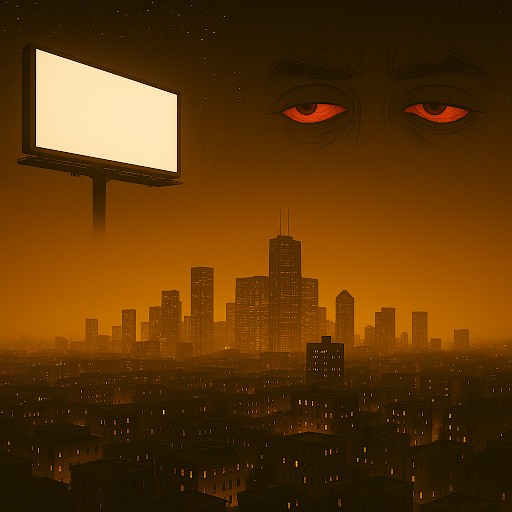
How Santa Monica’s Growing Light Pollution Is Eroding Human Health, Safety, and Sanity
There was a time when our coastal night meant something—when day left, stars emerged, and the world, at last, exhaled. Now, the downtown skyline hums with artificial light. The stars have practically vanished. And something else may be vanishing, too: our health, our safety, our sanity.
This is the age of light pollution—bright, loud, and blinding. And it may be one of the most overlooked threats to quality of life in modern cities. Like Flagstaff, Arizona, Palo Alto, and Los Altos in California, Santa Monica should be at the forefront of implementing and enforcing zoning and building codes that limit unnecessary illumination, including but not limited to advertising billboards, to ensure the night sky remains visible even within our commercial and urban areas.
California’s CALGreen Code (Section 5.106.8) integrates light pollution reduction into its building standards, enforcing limits on upward light, glare, and backlighting. However, is this truly sufficient? Is our city taking the initiative, as it does on many environmental issues, by prioritizing and enforcing the importance of this? We think not.
The Eternal Glow
High-powered streetlights, glowing billboards, glass towers lit from within, and floodlit roads all contribute to an environment of constant, low-level brightness. It’s easy to think this is a symbol of progress. But there’s a darker truth.
The human body is designed to follow the rhythms of natural light. Our circadian rhythm—a finely tuned biological clock—depends on the rise and fall of sunlight to regulate sleep, mood, hormone production, and even cellular repair. Artificial light at night, especially in urban environments, disrupts this cycle.
Medical studies have linked light pollution to:
- Reduced melatonin production and poor sleep quality
- Increased risk of depression and anxiety disorders
- Higher rates of obesity, diabetes, and cardiovascular disease
- Greater incidence of hormone-related cancers
In short, living in perpetual twilight doesn’t just steal our rest. It silently chips away at our health.
The Myth of More Light
City planners often argue that well-lit streets prevent crime and improve safety. In truth, excessive or poorly designed lighting can have the opposite effect.
Light pollution creates harsh contrast and deep shadows where danger can lurk. It reduces visibility through glare. It washes out security camera footage. And it gives a false sense of security to residents who assume brightness equals protection.
Worse, invasive lighting that spills into residential spaces—known as light trespass—erodes sleep and mental well-being. Apartment dwellers battle streetlamps that blast through curtains. Children sleep under ceilings that glow faintly blue from nearby billboards. People grow tired, irritable, and disconnected.
Over lighting is not urban safety. It’s an aesthetic distraction. And it’s making our cities sicker.
The Slow Unraveling
You might not notice it right away. The exhaustion builds gradually. You wake up groggy. You stop dreaming. You forget what real darkness looks like. Maybe your child asks what stars really are—and you realize he’s never seen a sky without haze.
These are the subtler, more haunting effects of light pollution. Not just physiological, but psychological. We are creatures of balance. Without darkness, our systems falter. Without rest, our thoughts fragment.
A Way Back to Night
The good news? There are ways to fight back—and they don’t require plunging cities into total blackout. Smart urban lighting strategies can dramatically reduce light pollution without sacrificing safety or aesthetics. Some of this is already on the books, but is not being enforced.
Solutions include:
- Shielded lighting: Fixtures that direct light downward, not skyward
- Smart streetlights: Systems that dim or deactivate when no one is present
- Stricter headlight regulations: Reducing headlight glare and ensuring proper alignment
- Zoning laws: Limiting the brightness of signs and outdoor lighting in Commercial and Residential areas
Urban darkness is not a threat. It is a natural necessity. One we’ve forgotten how to value.
Let’s Not Forget Those Headlights Like Hellfire
Another less-discussed culprit? Newer automobile headlights are increasing the risk on the roads.
Over the past two decades, modern vehicles have transitioned from traditional halogen bulbs to ultra-bright LEDs and high-intensity discharge (HID) systems. These lights are brilliant—efficient, powerful, and long-lasting. They are also often blinding.
Drivers now contend with a barrage of excessively bright, often misaligned headlights, especially from larger vehicles like SUVs and trucks. The outcome: road glare that can lead to temporary blindness, slower reaction times, and a rise in nighttime driving accidents. Pedestrians and cyclists are particularly at risk, disoriented by beams intense enough to turn crosswalks into interrogation rooms.
The technology may be newer, but the safety risks are very real and dangerous, as this can cause drivers to lose their focus—This Is a Growing Problem.
Final Thoughts
Light was meant to free us, to make us safer, smarter, and more evolved. But in our rush to conquer the dark, we’ve overlooked what it provided us: sleep, stars, privacy, and stillness. Without those elements, a city doesn’t truly rest; it lingers—lit up, yes—but anxious and out of balance.
So tonight, look up. If you can’t see the stars (or just a few), ask yourself what else have we blinded ourselves to in the name of progress?
Michael Jolly for SMa.r.t.
Santa Monica Architects for a Responsible Tomorrow
Samuel Tolkin, Architect & Planning Commissioner; Thane Roberts, Architect; Mario Fonda-Bonardi AIA, Architect; Robert H. Taylor AIA, Architect; Dan Jansenson, Architect & Building and Fire-Life Safety Commission; Michael Jolly, AIRCRE; Jack Hillbrand AIA, Landmarks Commission Architect; Matt Hoefler NCARB, Architect; Phil Brock, SM Mayor (ret)












